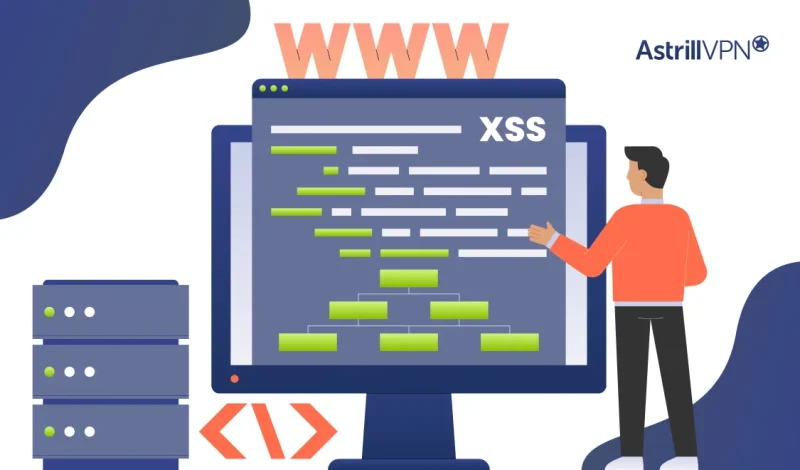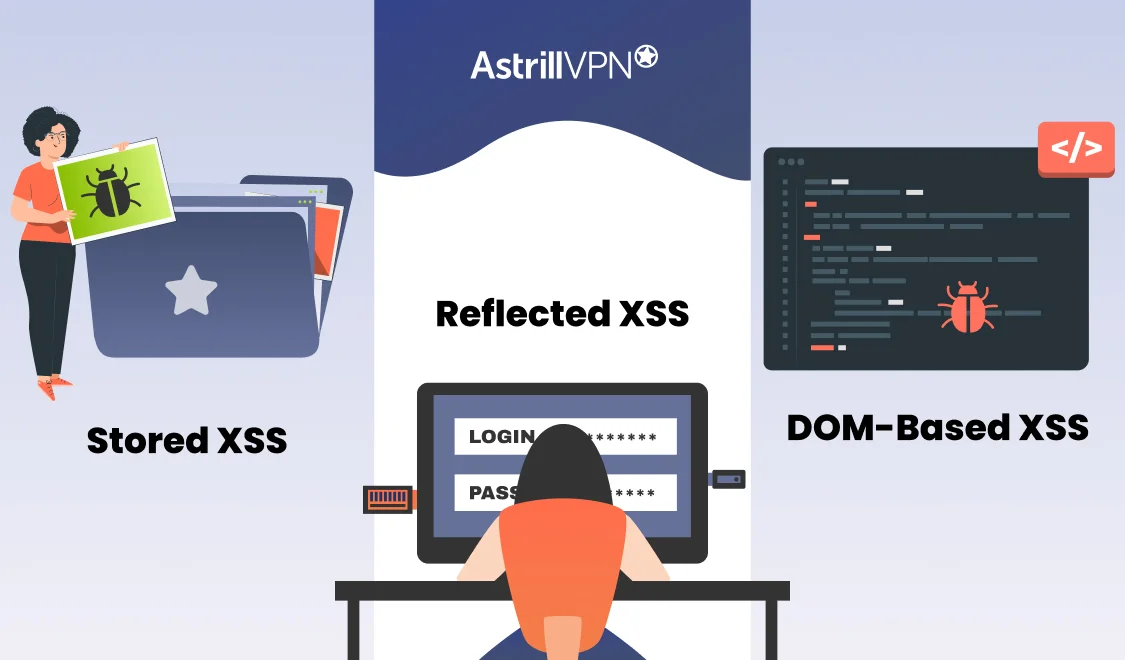Cross-Site Scripting (XSS) Explained: How It Works and How to Prevent It

Arsalan Rathore

Cross-site scripting (XSS) is a prevalent security vulnerability in web applications. It occurs when an attacker injects malicious scripts into otherwise benign and trusted websites. These scripts are executed in the victim’s browser, leading to potential security breaches, data theft, and unauthorized access. XSS typically exploits vulnerabilities in input validation and output encoding, making it a major concern for developers and cybersecurity professionals.
The term “cross-site” originates from the nature of these attacks, where malicious scripts from an external or untrusted source are executed within the context of a trusted site. This allows attackers to bypass the browser’s same-origin policy, a fundamental security feature that segregates scripts from different websites.
XSS is the #1 most common vulnerability type in 2025 (alongside SQL Injection), source: RecordFuture
In this blog, we will explore XSS, its various types, how these attacks work, real-world examples, and, most importantly, how to prevent and mitigate the risks associated with XSS vulnerabilities. Understanding and addressing XSS is crucial for any organization looking to maintain a secure online presence.
Table of Contents
Importance of Understanding XSS in Web Security
As web applications continue to dominate the digital landscape, the importance of safeguarding them against vulnerabilities like XSS cannot be overstated. XSS attacks pose severe threats to both individuals and organizations, including:
- Data Breaches: Attackers can steal sensitive user data, such as login credentials, financial information, and personal details.
- Session Hijacking: By exploiting session cookies, attackers can gain unauthorized access to a user’s account.
- Defacement: Malicious scripts can alter the appearance or functionality of websites, damaging brand reputation.
- Malware Distribution: XSS can deliver malware to users’ devices, amplifying the potential impact of an attack.
Types of XSS Attacks
Cross-site scripting (XSS) attacks are categorized into three primary types based on the method of injection and execution: Stored (Persistent) XSS, Reflected (Non-Persistent) XSS, and DOM-Based XSS. Each type poses unique challenges and risks for web applications and users.

1. Stored (Persistent) XSS
Stored XSS occurs when malicious scripts are permanently stored on a target server, typically within a database, message board, comment section, or other user input fields. When another user accesses the compromised page, the script is automatically executed in their browser. Stored XSS is particularly dangerous because it can repeatedly affect many users until the vulnerability is addressed.
How It Works:
- An attacker submits malicious input to a vulnerable form or field.
- The input is saved on the server without proper validation or sanitization.
- Other users view the content, triggering the execution of the embedded malicious script.
2. Reflected (Non-Persistent) XSS
Reflected XSS occurs when malicious scripts are injected into a web application but are not stored on the server. Instead, they are included in a URL or transmitted via HTTP parameters. The script executes when the user interacts with the crafted URL.
Reflected XSS attacks often target individuals rather than entire user bases, making them easier to execute and harder to detect. DOM-Based XSS can be challenging to detect because the malicious payload does not travel through the server. It exploits the logic of client-side scripts, making traditional XSS prevention methods less effective.
How It Works:
- An attacker crafts a malicious link containing the script.
- The user clicks the link, and the server reflects the malicious input in the response.
- The browser executes the script within the context of the vulnerable website.
3. DOM-Based XSS
DOM-Based XSS is a more advanced attack that manipulates the Document Object Model (DOM) on the client side. It does not rely on server-side vulnerabilities but exploits client-side JavaScript weaknesses.
How It Works:
- Malicious input is processed directly by the browser’s JavaScript engine.
- The client-side script dynamically modifies the DOM based on the input.
- The script executes in the context of the vulnerable webpage.
How Does Cross-site scripting (XSS) Work
Cross-site scripting attacks exploit vulnerabilities in web applications to inject malicious scripts into web pages viewed by users. By leveraging these vulnerabilities, attackers bypass security mechanisms like the same-origin policy, which restricts how scripts interact with resources from different origins. Here’s a detailed breakdown of how XSS attacks work:
1. Injection of Malicious Input
The first step in an XSS attack involves injecting a malicious script into a vulnerable input field or parameter. Attackers often use scripting languages like JavaScript, natively executed in most web browsers. The malicious code is passed on to the next stage if the web application fails to validate or sanitize these inputs. These inputs could be:
- Forms (e.g., login pages, comment boxes).
- URLs (e.g., query strings or fragments).
- Headers (e.g., cookies or HTTP headers).
2. Execution in the Browser
Once the malicious script is delivered to the victim’s browser, it is executed as part of the legitimate web page. The browser, trusting the origin of the web page, allows the script to run with the same permissions as the legitimate content.
Common execution methods include:
- Injecting code into dynamically generated HTML or JavaScript.
- Modifying the Document Object Model (DOM).
- Exploiting content delivery vulnerabilities like iframe inclusion.
3. Accessing Sensitive Information
Malicious scripts executed via XSS can perform a variety of harmful actions, including:
- Stealing Cookies: Cookies often store session tokens or authentication data. An attacker can use a document. cookie to extract this information and hijack the victim’s session.
- Keylogging: The script can capture keystrokes the victim enters, including login credentials or personal information.
- Accessing Browser Storage: Attackers can read data stored in localStorage or sessionstorage.
- Making Unauthorized Requests: The script can execute actions on behalf of the user, such as changing account settings or initiating transactions.
4. Targeting Other Users or Systems
XSS attacks often escalate beyond the initial victim. Attackers also use XSS as a foothold for larger attacks, such as distributed denial-of-service (DDoS) or data exfiltration. For example:
- Stored XSS spreads malicious scripts to multiple users when they access infected pages.
- Reflected XSS can redirect users to malicious sites or download malware.
Notable XSS Incidents in Recent History
Cross-site scripting (XSS) attacks continue to pose significant threats to web applications, with recent incidents underscoring the persistent nature of this vulnerability. Following are some notable XSS incidents that happened recently:
1. WordPress Plugin Exploitation (March 2024)
In March 2024, hackers exploited a vulnerability in outdated versions of the Popup Builder plugin for WordPress, infecting over 3,300 websites with malicious code. This attack highlights the risks associated with unpatched plugins and the widespread impact of XSS vulnerabilities in popular content management systems.
2. GitHub Vulnerability (2022)
In 2022, GitHub addressed a DOM-based XSS vulnerability within its search functionality. The flaw allowed attackers to craft input that modified the Document Object Model (DOM), executing malicious JavaScript when users interacted with specific search results. This incident underscores the importance of securing client-side scripts to prevent XSS attacks.
3. eBay XSS Vulnerabilities (2020)
eBay, a major online marketplace, experienced multiple XSS vulnerabilities in 2020 that put user data at risk. Attackers exploited reflected XSS vulnerabilities by crafting malicious URLs that executed scripts to steal user session cookies or redirect users to phishing websites. eBay addressed these vulnerabilities following reports from cybersecurity researchers.
4. GitHub Vulnerability (2022)
In 2022, GitHub, one of the world’s largest code hosting platforms, addressed a significant DOM-based Cross Site Scripting (XSS) vulnerability within its search functionality. The flaw, identified and reported by a security researcher through GitHub’s bug bounty program, allowed attackers to exploit the platform by injecting malicious input into the search bar.
This input manipulated the Document Object Model (DOM), enabling the execution of unauthorized JavaScript code when users interacted with specific search results. Although the vulnerability was promptly patched before large-scale exploitation occurred, the incident underscored the persistent risks associated with DOM-based XSS attacks.
How to Detect XSS Vulnerabilities
Cross-site scripting (XSS) is one of the most prevalent security vulnerabilities on the web, often going unnoticed until it’s too late. Detecting XSS vulnerabilities can feel daunting, but it’s a crucial step in protecting your web applications from malicious attacks. Fortunately, there are a range of methods, both manual and automated—that can help you uncover XSS risks before they turn into real-world threats.

1. Test User Inputs with Common Payloads
XSS vulnerabilities typically arise when user inputs aren’t properly sanitized. To detect them, test every input field on your website, from search boxes to contact forms, using common XSS payloads. Simple tests like entering <script>alert(‘XSS’)</script> in an input field will show you if the input is echoed back to the page without any filtering. If the script runs, you’ve identified a vulnerability.
2. Leverage Automated Scanners
While manual testing is essential, automated tools can save time and help uncover vulnerabilities across large sites. Tools like OWASP ZAP, Burp Suite, and Acunetix scan web applications for security flaws by injecting malicious scripts into input fields and analyzing the responses. These tools can quickly detect issues you might miss manually, especially in large or complex applications.
3. Review the Code for Insecure Practices
Even without specific tools, security-conscious developers can detect XSS risks by reviewing their code for insecure coding practices. Look for unescaped user input or vulnerable JavaScript functions like eval() or innerHTML, which are often used incorrectly and can allow attackers to inject malicious scripts. Ensuring proper sanitization and escaping of user input is key to preventing these vulnerabilities.
4. Use Static Application Security Testing (SAST) Tools
Static Application Security Testing (SAST) tools like SonarQube and Checkmarx are designed to analyze your source code for vulnerabilities, including XSS. These tools scan the code before it’s even run, catching issues at the development stage. Implementing SAST early in the development process can help identify potential XSS issues before they reach production.
5. Penetration Testing
Penetration testing involves simulating real-world attacks to identify vulnerabilities in your application. Engaging a professional penetration tester or using bug bounty programs lets you see how an attacker might exploit your site’s vulnerabilities. This real-world testing is invaluable in catching XSS risks that automated tools or code reviews might not detect.
6. Real-Time Monitoring and Logging
Even with all the right detection techniques, monitoring your application for suspicious activity is crucial once it’s live. Setting up real-time logging and monitoring tools can help you spot unusual behavior, such as unauthorized script execution or DOM manipulation, which could indicate an XSS attack. Tools like Splunk or ELK Stack allow you to analyze logs and track potentially harmful events in real-time.
Preventing and Mitigating XSS Attacks
XSS attacks can be effectively prevented and mitigated through a combination of secure coding practices, defensive measures, and security configurations. Here’s a quick look at the most important techniques:
1. Input Validation and Sanitization
Always validate and sanitize user input. Ensure that input follows the expected format, and remove any dangerous characters or tags before processing.
- Whitelist Validation: Only allow specific, validated input.
- Sanitization: Use libraries like DOMPurify to clean user input.
2. Output Encoding Strategies
Encode user input before displaying it to prevent the browser from interpreting it as executable code.
HTML Encoding: Convert characters like < and > to their HTML entities.
JavaScript and URL Encoding: Encode input when inserting it into JavaScript or URLs.
3. Implementing Content Security Policy (CSP)
Use a CSP to control which scripts and resources can be loaded on your site.
- Whitelist Sources: Only allow scripts from trusted domains.
- Block Inline Scripts: Disallow inline scripts to reduce risk.
4. Utilizing Security Headers
Set security headers to further protect your site from XSS.
- X-XSS-Protection: Enable browser-based XSS protection.
- Strict-Transport-Security (HSTS): Enforce HTTPS to secure connections.
- X-Content-Type-Options: Prevent MIME type sniffing.
5. How AstrillVPN Protects Against XSS-Related Risks
While XSS directly targets web applications, AstrillVPN significantly safeguards users through encrypting Traffic for Secure Communication, securing DNS, and protecting Against Malicious Website. It also provides data Integrity via VPN Tunnel.
FAQs
Stored XSS attacks occur when malicious scripts are permanently stored on a web server (e.g., in a database or message board) and are executed when a user accesses the infected page. The script is injected into the web application, typically through user input, and persists until removed.
In networking, XSS (Cross-Site Scripting) refers to a vulnerability in which an attacker injects malicious scripts into web pages that are viewed by other users. It exploits a user’s trust in a particular website, allowing the attacker to steal information, and session cookies, or execute malicious actions on behalf of the user.
An example of cross-site scripting is when a user submits a comment on a website with a script tag, like <script>alert(‘Hacked’);</script>. If the site doesn’t properly sanitize the input, the script can execute in other users’ browsers, displaying the alert or performing malicious actions.
Form fields, URL parameters, search bars, comment sections, and cookies are common entry points for XSS attacks. Any place where user input is processed and displayed without proper validation or sanitization can serve as an entry point for malicious scripts.


No comments were posted yet